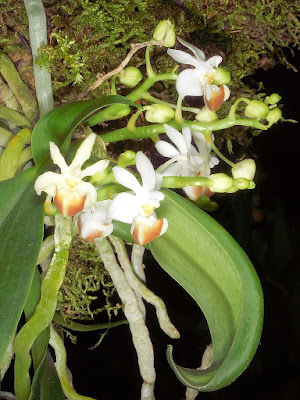Lobb's Phalaenopsis is native to the eastern Himalayas, northeastern India, Bhutan, Sikkim, Myanmar and Vietnam. These plants have their habitats at an altitude of about 366 - 457 m. They grow in piedmont or evergreen lowland forests on porous, uneven bark of trees in crevices filled with caries in which they grow roots.
Phalaenopsis lobbii orchid, also called as Lobb's Phalaenopsis (named in honour of Cornish plant hunter Thomas Lobb), Doritis lobbii, Doritis lobbii f. flava, Doritis lobbii f. flavilabia, Phalaenopsis decumbens var lobbii, Phalaenopsis listeri, Phalaenopsis lobbii f. flava, Phalaenopsis lobbii f. flavilabia, Phalaenopsis parishii var. lobbii, Polychilos lobbii, Phalaenopsis lobbii var. vietnamensis, is a species of the genus Phalaenopsis. This species was described by (Rchb. f.) H.R. Sweet in 1980.
IDENTIFY PHALAENOPSIS LOBBII ORCHID
Lobb's Phalaenopsis is native to the eastern Himalayas, northeastern India, Bhutan, Sikkim, Myanmar and Vietnam. These plants have their habitats at an altitude of about 366 - 457 m. They grow in piedmont or evergreen lowland forests or humid, mossy, mixed and coniferous forests on porous, uneven bark of trees in crevices filled with caries in which they grow roots.
It is a dwarf, hot to cool growing epiphytic species with broad elliptic leaves about 4 to 6 cm long. There are 1-2 leaves per plant, sometimes more and in nature they can be dropped during rest periods.
The lateral, 4" (10 cm) long, racemose or paniculate, few flowered inflorescence with small bracts that bear from 3 to 7 sequentially opening flowers. They can flower more than once a year but most often in the spring. Flowering occurs sequentially. In slightly cooler conditions, each flower lasts for about a month. The flowers are about 2.5 cm in size, they are fleshy, cream-white, in the shape of a star. The lip is white, semicircular with two vertical stripes in brown.
GROW AND CARE PHALAENOPSIS LOBBII ORCHID
Cultural information should only be used as a guide, and should be to be adapted to suit you. Your physical location; where you grow your plants, how much time you have to devote to their care, and many other factors, will need to be taken into account. Only then can you decide on the cultural methods that best suit you and your plants.
Light:
Phalaenopsis lobbii needs a light level of 12000-18000 lux. The ideal photoperiod is 12 hours. Plants tolerate better stronger light than most species of the genus Phalaenopsis. This kind of orchids loves bright sunlight and is able to tolerate direct morning and evening sun, however, in the hot summer noon (especially in the windows of southern orientation), the orchid should be protected from direct sunlight: put behind a curtain (for example, on a table near a window) or in the shadow of other plants, otherwise the plant can get a sunburn.
Temperature:
Lobb's Phalaenopsis refers to a warm temperature regime, and it is recommended to keep the orchids under the following conditions throughout the year: The average day temperature is 30-31 ° C, and at night it falls to 21-23 ° C with a daily amplitude of 7-9 ° C. These plants are extremely resistant to extreme temperatures.
Humidity:
This type of orchid loves high humidity and its should not fall below 70%. Too dry air adversely affects the development of the plant and its growth is inhibited. In winter, the humidity can drops even below 60%.
Substrate, growing media:
It can be grown both in pots or mounted. A suitable medium is fir bark of medium granulation. Plants grow well on cork or tree ferns in the crop, but then they require constant high humidity.
Repotting:
This species does not need frequent repottings, therefore they are carried out only when the substratum has aged, which happens about every 2-3 years. Obviously, if any problem occurs at the roots, the repotting is carried out immediately. Repotting is best done in early spring, immediately after flowering. Unless the roots are damaged, they should not be trimmed when repotting.
Watering:
Watering Phalaenopsis lobbii orchid directly depends on the temperature of the content, the higher it is, the more often and abundant it is necessary to water. The substrate between waterings should dry relatively well, but still, do not dry completely. And do not keep this plant very wet from November to mid January.
Fertilizer:
This species needs 1/4 - 1/2 standard dose of fertilizer given every week during the growing period. Since the growth period of this plant is relatively short, Phalaenopsis lobbii requires frequent fertilization during this time. Before fertilizing the plant it is necessary to water it to avoid the damaging effect of the fertilizer on the dry roots.
Rest period:
In nature, Phalaenopsis lobbii has a winter period of rest (2-4 months) with a significant reduction in precipitation (the humidity drops even below 60%) and a decrease in temperatures (the daytime temperature is 22-28 ° C, at night 8-14 ° C and often drops to 4 ° C), during which the orchid sheds all its leaves and subsequently blooms. Despite this, at home, it is recommended to abandon the annual rest period and grow an orchid all year round under wet, warm conditions. Such a significant deviation from the usual conditions of detention is due to the fact that in the conditions of flats after dropping the leaf cover, the plants are very long and heavily restored, refusing the consequence of flowering for a period of 2 to 3 years. And the absence of the rest period has no negative effect on the development of the plant.

















COMMENTS